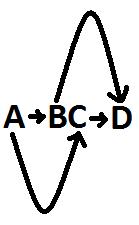Braess’s Paradox and Carmageddon
Earlier in July, there was a plan to widen a certain stretch of highway located in Los Angeles in order to reduce traffic congestion. If you’ve ever tried driving in Los Angeles during rush hour, you would know just how awful the problem is. It was not mere coincidence that the first “Rush Hour” film was centered in that very region. Now in order to perform the construction necessary for the widening of the road, the authorities had decided it was necessary to temporarily close off that 10-mile stretch of freeway for a little over 48 consecutive hours.
In class, we were shown an unintuitive example of Breass’s Paradox in which the addition of a new road could INCREASE the required travel time between two points all else equal. Then, it should also hold that the closure of a road might DECREASE the required travel time between two points. Yet given this possibility, why were millions of people panicking about this so-called Carmageddon that would take place over the course of these 2 days?
First of all, we must first realize that it took a specific example to show the possibility of Braess’s Paradox. If we were to examine the peculiarities of that example it should begin to become more clear why it doesn’t occur more often in real life. In the example, we are given several roads that have great length but arbitrary large width (e.g. A-C), and other roads with no length and no width. To see this, imagine you are the only car travelling along A-B. It takes you almost no time to make the trip, but add a second car and it takes you twice as long. If we draw the picture to scale, we find the graph looks something like this:
A rather exaggerated road network wouldn’t you agree? We would hope that our civil engineers would have more common sense then to create something like this. Any normal example with regular roads susceptible to congestion would reveal that closing off a road would naturally increase the number of cars travelling along other roads, which in turn increases congestion and travel time. Close off a major highway, and all the cars that would usually travel along that route would be forced to take smaller roads not intended to handle such a load and result in the chaos that was “carmageddon.”
See what happened here: http://www.latimes.com/news/local/carmageddon/

